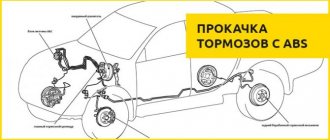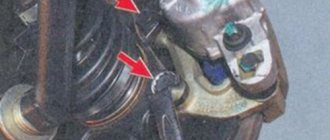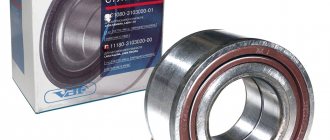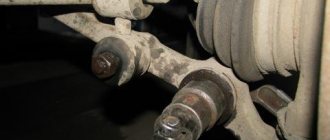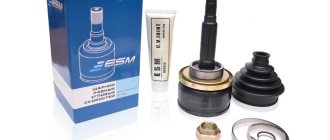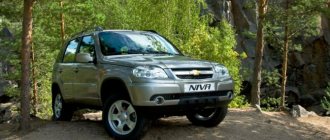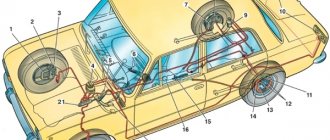The braking system is a very important factor for traffic safety. The Priora, like other cars, has a hydraulic brake system. In addition, many of the cars are equipped with an anti-lock braking system. This means that it is necessary to carefully monitor the fluid level in the expansion tank and the absence of air pockets in the tubes and components. And bleed the system in a timely manner.
BRAKE SYSTEM DEVICE
The Priora brake system includes the following elements:
master brake cylinder; fluid reservoir; piping system; working cylinders – 4 pcs.; brake drums; master cylinder vacuum; brake pedal. master brake cylinder As on all cars, the brakes on the Priora are pneumohydraulic. What it looks like in practice. The main part of the brake system is the master cylinder. It is located in the engine compartment. A container with an oily liquid is connected to it. It is called “braking”. The main brand used on Priora was Dot. It is widespread among Russian car enthusiasts and is well known to those who have tried to bleed the brakes. The master cylinder is filled with this liquid and acts like a syringe. When you press the brake pedal in the cabin, the piston of the master cylinder pushes the fluid in it into the pipeline system. Those, in turn, are connected to the working cylinders. Acting on the same principle, the working cylinder forces the locking pads to compress or, conversely, depending on the type of brake, to unclench, stopping the rotation of the wheels.
Braking requires quite a lot of effort from the driver. Making such an “injection” and bleeding the brakes on four wheels at once is not an easy task. Therefore, a solution was found: due to the vacuum in the intake system, a special mechanism, a vacuum, greatly facilitates this process. And the pedal is quite easy to press.
Important! It is the system, operating on the “syringe” principle, with many rubber seals, that requires the complete absence of air in the system, since its presence reduces the efficiency of the brakes to zero. Simply put, due to the difference in the density of air and brake fluid, instead of uniform pressure on the piston of the working cylinder, there will be a chaotic movement of air bubbles inside the system. Because of this, they sometimes need to be pumped.
FEATURES OF BRAKES WITH ABS (ANTI-LOCK BRAKING SYSTEM)
After the creation of the first hydraulic brakes, it soon became clear: completely jamming the wheels with pads does not improve braking performance at all. Moreover, it creates dangerous drifts. At first, drivers were taught jerk braking, that is, not keeping the pedal pressed constantly, but “pumping” by releasing and pressing the pedal with high frequency. The method is not very effective, because in critical situations, most drivers press the brake pedal firmly to the floor. And the same ABS was developed that is found on many Priora models.
PRINCIPLE OF OPERATION OF ABS
The basis of ABS, as in all systems of modern cars, is a computer. It is he who controls all the actions of the anti-blocker. ABS is practically built into the Priora braking system. The fluid from the main cylinder enters the “hydraulic unit”, in which the ECU (electronic control unit), pressure control valves and ERP (electric return pump) are mounted. In accordance with the signals from the wheel speed sensors, the ECU opens and closes the valves and, releasing pressure, creates the very necessary jerky “pumping” effect. Even if the driver presses the pedal without releasing it.
HOW TO BLEND THE BRAKES ON A PRIOR
The purpose of bleeding the brake system is to completely fill all devices and pipes with brake fluid. With a complete absence of air jams and bubbles. There is a special procedure for this, called bleeding the brakes.
Attention! It can only be done by two people. To perform this you will need the following tools and devices:
special key for the valve (bleeder fitting); transparent container for draining brake fluid; a thin flexible hose for fitting onto the working cylinder fitting; 1 – 1.5 liters of DOT brake fluid.
The process of bleeding the Priora brakes must be carried out in an inspection pit or on a lift. This procedure is carried out either after any repair of the brake system, or during the annual technical inspection of the car. Also, if suddenly there is a feeling that the brake is not working correctly, you feel the pedal sinking or, conversely, jamming without braking.
STARTING THE UPGRADING PROCESS
So, the Priora needs to be driven into a pit or lifted onto a lift. One person must be behind the wheel to apply the brakes, the second must work under the car. You must first check the brake fluid level in the expansion tank. If there is not enough of it, add it. In general, before bleeding the brakes on a Priora, you need to make sure that there is more fluid in the expander than the usual norm. That's it, the liquid is filled, now you need to pump it.
It usually starts from the front left wheel. On the inside of the wheel rim (hub) you can see a valve - a fitting for the working cylinder. It is closed with a special rubber cap. It is necessary to remove the cap and place a rubber tube on the nipple. Place the other end of the tube into a transparent container filled with brake fluid. Prepare a special key for the valve. The driver must fully press and release the brake several times and pump until the Priora pedal is at the highest point.
Then the person at the bottom of the wheel must release the valve with a key and release the pressure in the working cylinder. In this case, you need to carefully watch the liquid, watching for air bubbles escaping, while not releasing the pedal. And as soon as it falls to the floor, tighten the valve. Pump in this way several times. You must wait until there is no more air in the escaping brake fluid. Then you need to drain the liquid for the last time and fix the valve. Place the cap and check the brake fluid level in the reservoir.
Read also: Lukoil Genesis line of oils
Now repeat the same procedure completely, bleed the brakes on the right front wheel. Do everything the same way.
Attention! Do not forget to add brake fluid to the expansion tank. Under no circumstances should it be empty, so check after each wheel. After bleeding the brakes of the right front wheel, you need to go back and bleed the brakes first on the rear left, and then on the rear right wheel. The brake pumping cycle for the rear wheels is 1.5 times longer, that is, if it is enough to pump the cylinder 3 times at the front, then the rear wheels need to be pumped at least 5 times. After this, finally add brake fluid to the Priora expansion tank, check the tightness of the bypass valves and the presence of protective caps. That's it, field tests can be carried out. Drive a short distance and check the brakes at low speed.
FEATURES OF PUMPING BRAKES ON A PRIOR WITH ABS
There is no difference in this process for Priora. Both with and without ABS, the operating algorithm remains the same. Pump it the same way and check the result.
The car is equipped with two braking systems - working and parking.
The service braking system is designed to reduce the speed of the vehicle, until it comes to a complete stop and briefly holds the vehicle stationary.
The service brake system is dual-circuit, diagonal, hydraulically driven, and consists of a master cylinder with a vacuum booster, four wheel brakes and a fluid pressure regulator in the rear brakes.
The front wheel brakes are ventilated discs, the rear wheels are drum brakes.
Each of the car’s circuits includes brake mechanisms for two wheels: one front and one rear, located diagonally on the car.
One circuit includes the brake mechanisms of the front right and rear left tracks, and the second circuit includes the brake mechanisms of the front left and rear right tracks.
If one circuit fails, the second circuit, albeit with less efficiency, will ensure the vehicle stops.
The fluid pressure regulator limits the flow of fluid to the rear brake mechanisms when there is insufficient load on the rear axle, thereby preventing the rear wheels from locking and the rear axle of the vehicle from skidding during sudden braking.
The regulator body has a control hole closed with a plastic plug.
Liquid leakage from this hole indicates leakage of the regulator rings.
To reduce the force applied by the driver to the brake pedal, a vacuum booster is installed in the brake system drive, which operates due to the vacuum generated in the intake manifold of a running engine.
A brake fluid reservoir is installed on the brake master cylinder body.
A sensor for insufficient brake fluid level is built into the lid of the bank.
If the liquid level in the tank drops dangerously, the sensor turns on the warning lamp on the instrument panel.
Some vehicles are equipped with an ABC (anti-lock) braking system.
Anti-lock braking system ABS: types, types
Depending on the type and type, ABS is classified into:
- One scheme of operation of the ABS system is when all the devices that make up the ABS are located in one unit. That is, the hydraulic valve block, hydraulic accumulator and pump are located in one unit.
- The second ABS scheme is when the component devices (hydraulic valve block, hydraulic accumulator and pump) are located in different places. In this type of braking system, in addition to the ABS module, there is also an ESP module and an SBC module.
Bleeding the brake system
| Bleed the brake system while wearing safety glasses. If brake fluid accidentally gets into your eyes, rinse them immediately with plenty of water and seek medical attention! |
| The hydraulic system is pumped in order to remove air from it that enters the system when servicing the brake mechanisms, replacing hydraulic lines or the turbocharger, as well as when the fluid level in the master cylinder reservoir drops below the minimum permissible value. |
| Models with ABS |
Anti-lock brake system (ABS) device
When braking, ABS regulates fluid pressure in the working cylinders, preventing the wheels from completely locking. Thanks to this, the braking distance is reduced and the driver continues to control the vehicle’s trajectory even during intense braking on snow, sand or wet asphalt.
The principle of operation of the abs system. Video:
The anti-lock braking system includes the following parts:
- Control block. Electronics that change pressure by opening and closing bypass valves. It analyzes information about wheel rotation. When the wheel stops, the valve partially relieves pressure and the pad presses less.
- Sensors that control rotation speed. The devices are mounted on wheel hubs and operate due to the Hall effect. They transmit information to the ECU.
- Hydraulic block. It consists of hydraulic accumulators, solenoid valves for inlet and outlet, an electrically driven pump and damping chambers.
Useful tips
How to bleed ABS brakes on Priora, Kalina and Honda Civic correctly? To prevent the work from causing harm to your car, and you don’t have to take it to a car service center, you should remember a few rules. Self-replacement of brake fluid for Lada Priora. Step-by-step writing of the work with illustrations.
Firstly, you do not need to turn on the ignition for more than 15-20 seconds. Otherwise, this will lead to failure of the electric pump. Secondly, it is necessary to take breaks between pumping the wheels. After all the air (aired mixture) has come out of one wheel, you should not immediately move to the second. You need to wait about 5-10 minutes until the air in the system completely disappears.
- Why does the electric power steering turn off on a Kalina? Replacing the electric power steering control unit
- Fuse block Kalina 2, its diagram, assignment of all fuses and relays (21925, 21927 Lux)
- Vaz Kalina tire sizes - Size tables
- How to tighten the handbrake on Kalina or replace its cable
How to bleed ABS brakes correctly and quickly
The procedure for bleeding the brakes is influenced by the design of the system, the location of components and the presence of additional electronic modules. You need to start by relieving the pressure in the hydraulic accumulator. To do this, you need to turn off the ignition (it is not necessary to start the engine) and pump the pedal.
A simple secret to quickly pumping brakes. Video:
Read how to bleed ABS brakes and stock up on the following materials, parts, accessories and tools:
- spanner;
- a rubber (possibly plastic) hose with a diameter corresponding to the thickness of the fitting tip;
- brake fluid;
- container (necessarily transparent) into which you will drain the old brake fluid.
You cannot do without an assistant who must press the pedal on command. You will perform manipulations with the fittings that ensure the removal of liquid.
Bleeding ABS brakes, where the components are located in one unit, differs little from the standard procedure. The only thing you need to do is turn off the system by pulling the fuse. This method works on domestic Ladas.
You can take advantage of the built-in pump. Then you will have to pump with the ignition on or even with the engine running. The procedure for bleeding the brakes starts with the right front cylinder and looks like this:
- disconnect the terminal of the level control sensor fixed on the expansion tank cover;
- remove the cover;
- open the brake reservoir;
- fill the reservoir to the brim with brake fluid;
- put the hose on the tip of the fitting;
- lower the end of the hose into a container to collect liquid;
- open the fitting by turning it a quarter or half a turn;
- to activate electronic systems, turn on the ignition;
- release the brake;
- wait until the pump expels the airy mixture;
- release the brake pedal;
- Tighten the fitting with a wrench.
The brake bleeding scheme is no different on any car. First, air is removed from the “far” circuit (for “left-hand drive” cars it is on the right), then from the “near” circuit.
Important: When bleeding, keep an eye on the brake fluid level. If it falls below the minimum, the system will fill with air. Then the work has to be done again.
To bleed a system with components located in different places, a diagnostic tester is needed. It connects to the car and allows you to control electronic components using a smartphone or computer. In this case, you will also have to unscrew the fittings and drain the airy liquid. However, no manipulation of the pedal is required. Instead, the valves and electric pump must be activated using the appropriate menu items. This way you can bleed the systems on the VW Passat B6 and other modern cars.
How to properly bleed ABS brakes
To achieve a good result, you will need an assistant, with whom you first need to bleed the brake system of the front wheels, then the rear ones.
Important! There can be high pressure in the brake system, up to 180 atmospheres, so you must first relieve the pressure.
You can bleed, that is, reduce the pressure by discharging the pressure accumulator. To discharge the pressure accumulator, you need to turn off the ignition and press the brake pedal many times (about 20 times).
After this, you need to disconnect the connectors on the brake fluid reservoir. If suddenly, while driving, in a front-wheel drive car, bad sounds begin in the area of the front wheels: grinding, crunching sounds, then these are most likely signs of a CV joint malfunction.
The brakes are bled when it is necessary to remove air from the brake system. This often happens when replacing brake fluid, which is done approximately every 50-60 thousand km. mileage or once every 2 years.
It is also necessary to bleed the brakes after repairing the brake system: replacing the master cylinder or vacuum brake booster. The need for bleeding also arises when depressurization occurs due to damage to the hoses, or when the liquid in the expansion tank drops below the minimum mark.
The pedal will indicate that you need to bleed the brakes - it will become soft and begin to sink. And the brakes themselves will become more sluggish. However, this could also indicate a more serious problem with the brake rotor or pads. So, if bleeding does not help, perhaps you should still contact a specialist - brakes are no joke!
How to bleed ABS brakes yourself
Good day, dear car enthusiasts! There is most likely no driver among us who has not at least once experienced a feeling of helplessness at the moment of braking. When the car continues to move, and not at all in the direction the driver wants. Skid.
Fortunately, engineering does not stand still. The modern driver is armed with a system such as ABS. Let's take a closer look at the system and see if it is possible to bleed ABS brakes yourself.
What is car ABS
ABS (Anti-lock Braking System) is an anti-lock braking system that prevents the wheels from locking during emergency braking.
The main task of ABS is to regulate the speed of rotation of all wheels. This is done by changing the pressure in the car's brake system. The process occurs using signals (pulses) from each wheel sensor that enter the ABS control unit.
How the anti-lock braking system works
The contact patch of the car's wheels is relatively stationary to the road surface. According to physics, the wheels are affected by the so-called. static friction force.
Taking into account the fact that the static friction force is greater than the sliding friction force, ABS effectively slows down the rotation of the wheels at a speed that corresponds to the speed of the car at the moment of braking.
At the moment the braking begins, the anti-lock braking system begins to constantly and quite accurately determine the rotation speed of each wheel and synchronizes it.
Anti-lock braking system device
Here are the main components of ABS:
- sensors installed on the wheel hubs of a car: speed, acceleration or deceleration;
- control valves installed in the line of the main brake system. They are also components of the pressure modulator;
- ABS electronic control unit. Its task is to receive signals from sensors and control the operation of valves.
Bleeding brakes with ABS, taking into account the characteristics of the system
Bleeding an ABS brake system will require you to have certain technical skills. In addition, it will not be superfluous to first study the manual on the design and maintenance of the brake system of your car.
Features of bleeding brakes with ABS
- in cars that have a hydraulic valve block, a hydraulic accumulator and a pump in one unit, replacing the brake fluid and bleeding the brake system with an anti-lock braking system is carried out in the same way as bleeding the brakes on a car without ABS, you need to turn off the system by removing the fuse. Bleeding of the circuits is carried out with the brake pedal pressed, the RTC bleeder fitting must be unscrewed. The ignition is turned on and the pump expels air from the circuit. The bleeder screw is tightened and the brake pedal is released. An extinguished malfunction light is evidence that your actions were correct.
- Bleeding the brake system with ABS, in which the hydraulic module with valves and the hydraulic accumulator are separated into separate units, is carried out using a diagnostic scanner to retrieve information from the ABS ECU. It's unlikely you have one. Therefore, bleeding of brakes with ABS of this type should most likely be done by you at a service station.
- Bleeding the brake system with ABS and electronic activation systems (ESP or SBC) is carried out only under service conditions.
How to bleed ABS brakes
It is important! It should be remembered that the pressure in the brake system reaches 180 atm. Therefore, in order to prevent the release of brake fluid, before disconnecting the brake lines on any system with ABS, it is necessary to discharge the pressure accumulator. To do this, with the ignition off, press the brake pedal 20 times.
Technology for bleeding the brake system with ABS
Bleeding brakes with ABS, like bleeding a conventional brake system, is done with an assistant. Turn off the ignition (position “0”). Disconnect the connectors on the brake fluid reservoir.
Front wheel brakes:
- put the hose on the bleeder fitting;
- open the fitting back;
- the brake pedal is pressed all the way and held in the depressed position;
- we observe the release of an “aired” mixture;
- tighten the fitting and release the pedal.
Rear right wheel brake:
- put the hose on the bleeder fitting, unscrew it one turn;
- press the brake pedal all the way, turn the ignition key to position “2”. In this case, the brake pedal is held in the pressed position;
- a running pump will expel air from the system. That is, as soon as the brake fluid begins to come out without air bubbles, close the fitting and release the brake.
Rear left wheel brake
- The hose is put on the fitting and unscrewed 1 turn;
- DO NOT press the brake pedal;
- a working pump pushes out the “aired” mixture;
- press the brake pedal halfway and tighten the fitting;
- release the pedal and wait until the pump stops completely.
In reverse order: ignition key to “0”, connect the connectors to the brake fluid reservoir, check the brake system for leaks (see ABS fault indicator).
Good luck with bleeding your ABS brakes.
ABS bleeding sequence
- First, we look for and remove the fuse in the fuse block that is responsible for the operation of the anti-lock braking system.
- Next, we jack up and remove one front wheel, and look for the brake wheel cylinder (BWC) fitting.
- After this, we put a hose on the fitting (from a hydraulic level, for example).
- Open the fitting one turn.
- One presses the brake pedal all the way and holds it in that position.
- Now turn the ignition key to turn on the hydraulic pump (the ABS indicator lights up on the instrument panel).
- The second person watches how air is removed through the hose and, after removing the air, tightens the fitting.
- We release the brake pedal only after tightening the fitting.
- Now, how do you know that all the air has escaped from the ABS? This shows the ABS icon on the dashboard, if it goes out after removing the air and tightening the fitting, then all the air has escaped.
There is a special order for properly bleeding an anti-lock brake system: right front wheel, then rear, then rear right, and then rear left wheel. If during such work the fuel fluid leaks out of the system, it is necessary to fill the system with new fluid. And to do this, you need to know what fluids can be mixed and how much brake fluid is needed to replace.
Special device for bleeding brakes
In this episode of Technical Environment, its host Gennady Emelkin will talk about how to replace it yourself.
| Models with ABS |
https://www.youtube.com/watch?v=ytabout
The disadvantage of old brakes was that one or more wheels would lock when the pedal was pressed to the floor. As a result, the car lost control and skidded, especially on slippery roads. Later, the traditional system was modernized by adding the following elements:
- hydraulic valve block;
- electric pump;
- capacity - hydraulic accumulator;
- wheel rotation sensors;
- electronic control module (ECU).
The listed components and parts are components of the anti-lock braking system. Thanks to them, a car with ABS never skids, since the automatic system simulates repeated sharp presses on the brake pedal, although the driver presses it all the way.
There are 2 types of brake circuits on cars: three- and four-channel. In the first case, the front wheels are connected to the main brake cylinder by separate branches, and the two rear wheels are connected by a single circuit. In the second scheme, each wheel has its own liquid line.
To understand the difference between bleeding a brake system with ABS, it’s worth understanding its operation:
- When the driver brakes under normal road conditions, the sensors on the wheels record approximately the same deceleration (taking into account turning) and the ABS does not manifest itself at all.
- When you press the pedal sharply, one or more wheels lock and rotate slower than the others, which the sensor reports to the ECU.
- At the command of the controller, the hydraulic unit opens the corresponding valve and the pressure in the circuit of the stopped wheel drops. Excess brake fluid flows into a storage tank.
- The pads release the disc (or drum) and the wheel spins along with the rest. But since the goal is to brake quickly, the ECU switches the valves again, the pads “grab” and hold the disc until the sensor detects the lock again. The cycle repeats until it stops completely.
- To prevent pressure in the master cylinder from dropping during valve actuation, an electric pump replenishes the brake fluid by pumping it from the hydraulic accumulator.
One described cycle takes a fraction of a second. The interaction of the fluid circuits with ABS is felt when the pedal is fully depressed. Due to the rapid operation of the valves and the pumping of fluid, the driver feels a series of shocks.
Description of design
The service brake system is hydraulic, dual-circuit, with diagonally separated circuits. In normal mode, when the system is working properly, both circuits operate. If one of the circuits fails (depressurizes), the other circuit provides braking to the vehicle, although with less efficiency.
Elements of the brake system : 1 — front wheel brake disc; 2 — front wheel brake tube; 3 — front wheel brake hose; 4 — hydraulic drive reservoir; 5 — main brake cylinder; 6 — vacuum booster; 7 — brake pedal; 8 — rear wheel brake tube; 9 — pressure regulator; 10 — rear wheel brake mechanism; 11 — rear wheel brake hose; 12 - floating bracket
The service brake system includes wheel brakes, a pedal assembly, a vacuum booster, a master cylinder, a hydraulic reservoir, a pressure regulator in the rear wheel brakes, as well as connecting tubes and hoses. The brake pedal is a suspended type. A brake signal switch is installed in the pedal bracket - its contacts close when the brake pedal is pressed.
Pedal assembly with vacuum booster and main brake cylinder : 1 - brake pedal; 2 — brake pedal bracket; 3 - vacuum booster; 4 — hydraulic drive reservoir; 5 - master brake cylinder
The vacuum brake booster is located between the brake pedal and the master cylinder and is attached with two nuts to the brake pedal bracket, which in turn is attached to the body. The vacuum amplifier is non-separable; if it fails, it is replaced with a new one. The brake master cylinder is attached to the vacuum booster housing with two studs. On top of the cylinder there is a reservoir for the hydraulic drive of the brake system, which contains a supply of fluid. There are markings for the maximum and minimum liquid levels on the tank body, and a liquid level sensor is installed in the tank lid, which, when the liquid level drops below o, turns on the alarm in the instrument cluster. When you press the brake pedal, the pistons of the master cylinder move, creating pressure in the hydraulic drive, which is supplied through tubes and hoses to the working cylinders of the wheel brake mechanisms.
Read also: Filter element for Lada Granta heater
Front wheel brake mechanism : 1 - shoe guide; 2 — caliper; 3 — brake pads; 4 — brake disc; 5 — brake shield; 6 — locking plate; 7 — screw securing the cylinder body to the caliper; 8 — hydraulic brake bleeder fitting; 9 — wheel cylinder; 10 — bolt securing the cylinder to the guide pin; 11 — guide pin; 12 — guide pin cover
The front wheel brake mechanism is a disc brake with a floating caliper, which includes a caliper and a single-piston wheel cylinder, tightened together with two screws. The brake shoe guide is attached to the steering knuckle, and the bracket is attached with two bolts to the guide pins installed in the shoe guide holes. Protective rubber covers are installed on the fingers. Grease is placed in the holes for the pins of the pad guide. The brake pads are pressed against the guide grooves by springs. When braking, the fluid pressure in the hydraulic brake mechanism increases, and the piston, moving out of the wheel cylinder, presses the inner brake pad against the disc. Then the bracket (by moving the guide pins in the holes of the pad guide) moves relative to the disc, pressing the outer brake pad against it. In the cylinder body, attached to the caliper, there is a piston with a rubber sealing ring of rectangular cross-section. Due to the elasticity of this ring, a constant optimal gap is maintained between the disc and the brake pads.
Elements of the front wheel brake mechanism : 1 - bolt securing the cylinder to the guide pin with a locking plate; 2 — screw securing the cylinder to the caliper; 3 - cylinder; 4 - block; 5 — caliper; 6 - guide pin; 7 — guide pin cover; 8 — pad guide
Rear wheel brake mechanism : 1 - lower tension spring; 2 — front block; 3 - pressure spring; 4 — spacer bar; 5 - working cylinder; 6 — upper tension spring; 7 — parking brake drive lever; 8 — rear block; 9 — tip of the parking brake cable
The rear wheel brake mechanism is a drum type, with a two-piston wheel cylinder, two brake pads and a device for automatically adjusting the gap between the pads and the drum. The automatic clearance adjustment device is located in the wheel cylinder. The main element of the device is a steel split thrust ring mounted on the piston with an axial clearance of 1.25–1.65 mm. The thrust rings (two per cylinder) are inserted into the cylinder with tension, providing a shear force along the cylinder surface of at least 350 N, which exceeds the force of the brake shoe tension springs. When the brake linings wear, the thrust rings shift under the action of the pistons by the amount of wear.
Elements of the rear wheel brake mechanism : 1 - front block; 2 - pressure spring; 3 - spacer bar; 4 - upper tension spring; 5 - finger; 6 — washer; 7 - cotter pin; 8 — rear block; 9 — parking brake drive lever; 10 - lower tension spring
If the cylinder mirror is damaged under the influence of mechanical impurities in the brake fluid, or under the influence of corrosion (presence of water in the brake fluid), the rings may “sour” in the cylinder and one or even both pistons will lose mobility. In this case, the cylinders must be replaced.
Pressure regulator in the hydraulic drive of the brake mechanisms of the rear wheels : 1 - earring; 2 - bracket; 3 - elastic lever; 4 — bracket; 5 - drive; 6 - pressure regulator
Fluid is supplied to the brake mechanisms of the rear wheels through a pressure regulator located on the underbody in front of the rear suspension beam. As the load on the rear axle of the vehicle increases, the elastic adjuster arm connected to the rear suspension beam is loaded, transmitting force to the adjuster piston. When you press the brake pedal, fluid pressure tends to push the piston outward, which is prevented by the force from the elastic lever. When the system comes into balance, a valve located in the regulator shuts off the flow of fluid to the wheel cylinders of the rear wheel brakes, preventing further growth of braking force on the rear axle and preventing the rear wheels from locking ahead of the front wheels. As the load on the rear axle increases, when the traction of the rear wheels with the road improves, the regulator provides greater fluid pressure in the wheel cylinders, and vice versa - with a decrease in the load on the rear axle (for example, when the car “pecks” during heavy braking), the pressure decreases.
Parking brake system : 1 - rear block; 2 — parking brake drive lever; 3 - spacer bar; 4 — cables; 5 - equalizer; 6 — adjusting rod; 7 — parking brake lever; 8 - brake drum
The drive of the parking brake system is manual, mechanical, cable, on the rear wheels. It consists of a lever with an adjusting rod, an equalizer, two cables, levers in the brake mechanisms of the rear wheels and spacer bars. The parking brake lever, mounted between the front seats on the floor tunnel, is connected to two cables through a rod and equalizer. The rear cable ends are connected to the parking brake drive levers mounted on the rear shoes. The parking brake is adjusted by rotating the adjusting nut located on the lever rod.
Conclusion
After carrying out repair and maintenance work on critical components of the car, before driving, you must first check the tightness of the system and the operability of the vehicle components.
ABS - Anti-lock Braking System is a system against wheel locking during heavy braking. Thanks to the fact that ABS prevents the car from skidding along the road, safety increases in emergency situations. The anti-lock braking system will operate correctly if the system is not air-filled.
https://www.youtube.com/watch?v=ytadvertise
Watch this helpful video. Tests show that even a working ABS system turns off at the end of the braking distance, so you still need to modify it with your foot.
